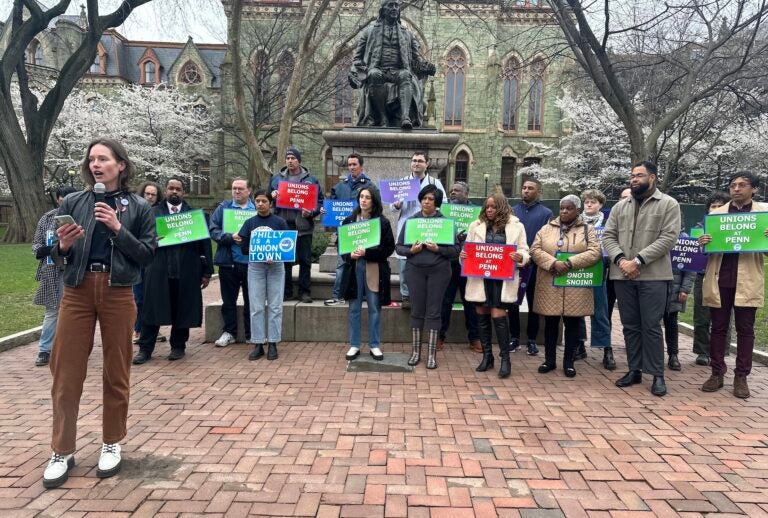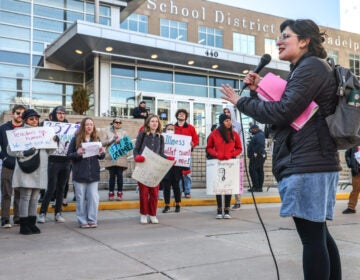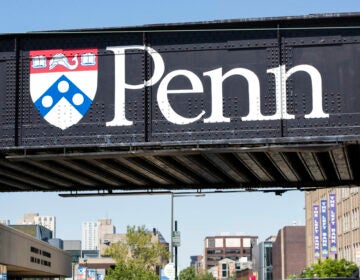Thousands of Penn grad students may vote to unionize next month
It’s been a long road to unionize graduate students at the University of Pennsylvania but if successful, it would include about 4,500 workers.
Listen 1:04
Luella Allen-Waller, a graduate student inside the University of Pennsylvania's biology department said 3,000 of her colleagues signed petition cards to join the union. (Kristen Mosbrucker-Garza/WHYY)
From Philly and the Pa. suburbs to South Jersey and Delaware, what would you like WHYY News to cover? Let us know!
After years of organizing, thousands of graduate student workers at the University of Pennsylvania will decide whether or not to unionize in mid-April.
The Graduate Employees Together University of Pennsylvania, or GET-UP, is behind the drive to affiliate with the United Auto Workers, which often represents student unions. Organizers hope that a majority of the 4,500 potential members will vote in favor of a new union on April 16 and 17.
At least 30% of UPenn graduate students signed a petition to hold a union election in October 2023.
“We will have overwhelming support,” said Luella Allen-Waller, a graduate student in the biology department, noting that 3,000 graduate student workers signed petition cards last fall. “Enthusiasm has only grown.”
The election was delayed for several months until the National Labor Relations Board ruled on March 19 that about 300 graduate students — those who are Educational Fellowship Recipients — aren’t eligible to participate in the union. GET-UP is currently fighting back against that ruling.
Graduate students typically spend about six years working towards their Ph.D. degrees and work as teaching or research assistants at the university.
Each week, Allen-Waller spends between 40 and 60 hours a week as a research assistant, which includes working on her own Ph.D. thesis.
The average research assistant contributes by planning experiments, processing results, analyzing data, writing research papers, spending hours in the lab, or dissecting samples.
“All of these eventually can go into things like patents that the university directly profits off of. Or can contribute to our advisors and professors being able to get grants,” she said.
Teaching assistants help ensure classes run smoothly, including hours of grading and lesson planning each week as well as instruction.
Luckily, Allen-Waller is not carrying undergraduate degree debt. Her friends aren’t so lucky, especially those with private loans looming over their heads.
“Not everybody is getting by. I know people in my building who skip lunch at the end of the month because they don’t have the money to buy food,” she said.
For decades, those students were not considered employees.
That changed in 2000, when the National Labor Relations Board ruled that graduate students at private universities have the right to organize as any other employee.
By 2002, The Union for Graduate Employees at New York University formed the first union of its kind at a private university. It is also affiliated with the United Auto Workers.
There were two previous unionization efforts by GET-UP at the University of Pennsylvania that were not successful.
In 2003, the first unionization effort at the University of Pennsylvania died after the National Labor Relations Board ruled against graduate student unions at private universities. At the time, the federal agency was overseen by the Bush administration.
In 2017, the National Labor Relations Board ruled that all graduate students at the University of Pennsylvania — including those in the business and engineering schools — should be eligible to vote.
By 2018, GET-UP withdrew its union petition during the Trump administration as a strategic move.
Graduate students at Brown, Columbia, Cornell and Harvard universities have formed unions in the past decade. Union dues for graduate students range between 1.44% and 2% of annual pay.
If successful, union organizers say they want higher stipends.
“Many of us have families to support,” she said. “We would like better dependent care and child care benefits.”
International students struggle with the high cost of visas and taxes, she said.
Graduate students at the University of Pennsylvania earn a minimum stipend of $38,000 during the academic year. The biggest increase happened in the past year when the minimum stipend jumped by $8,000. The university touts that it has raised the minimum stipend yearly by an average of 3.7% since 2005.
“We encourage all graduate and professional students who are eligible to vote to learn as much as possible about this significant issue and to vote,” said Ron Ozio, a spokesperson for the University of Pennsylvania, in a recent email.
The university estimates the value of its funding packages for Ph.D. students, which include scholarships to cover tuition and fees, stipends, medical insurance, and gym memberships, is $88,244. There are discounts for dental insurance and grants for graduate students with children.
The university argues that graduate student unionization would “potentially damage the collegial relationships between students and mentors” because faculty members would become supervisors of graduate students.
“At Penn, we engage as a community to advance what is important to us all – a dynamic and supportive academic environment,” according to a letter from the University of Pennsylvania’s Provost.
Penn graduate student Allen-Waller said she’s hoping for a ripple effect in higher education.
“There’s lots of conversations at universities about Democratic governance. I think unions have a big role to play,” she said.

Get daily updates from WHYY News!
WHYY is your source for fact-based, in-depth journalism and information. As a nonprofit organization, we rely on financial support from readers like you. Please give today.





